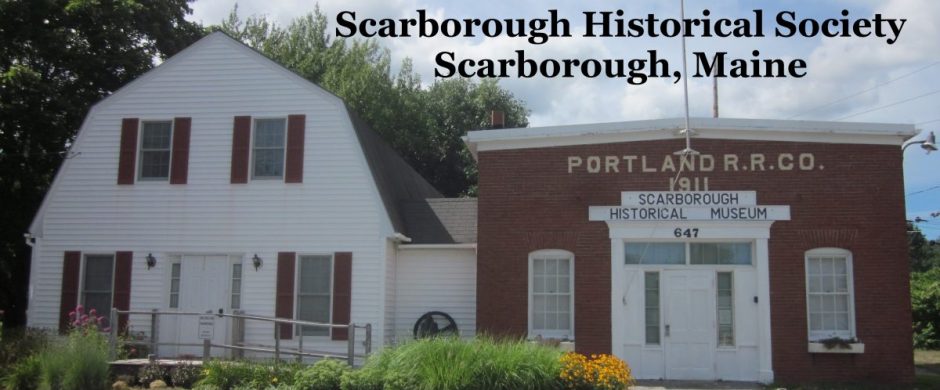Text by Bruce Thurlow
Images from Scarborough Historical Society, Rodney Laughton and Don Googins
Scarborough has always been a place where going to sea and fishing are a part of life. At one time ships, boats, and smaller watercraft were built in Scarborough, but the town does not share the same long shipbuilding history of many other Maine coastal and river towns. There was a brief period when Dunstan Landing was an important port and shipyard.
Shipbuilding: Sailing Ships
Shipbuilding operations at Dunstan Landing spanned the period from just after the Revolutionary War to the mid-1800s. Before the war, raw materials for building ships were sent to England. The area was heavily forested, much of it with tall pines ideally suited for masts and straight boards for the ships of the King’s Royal Navy. Most of the pines measured about a yard across and one hundred feet high and grew so close to each other there was no room for limbs to sprout for the first eighty feet. After the Revolutionary War, local craftsmen began building their own ships. Shipbuilding was often a side profession for those who knew carpentry. The abundance of trees, particularly the huge pines, many sawmills, a protected port and local sea captains needing ships for fishing and trade presented a perfect opportunity for building ships.
Before roads, railroad bridges and tide gates, ocean water overflowed the marsh at high tide. Boats were able to sail up the Scarborough River and over the marsh to Dunstan Landing. It was difficult to navigate larger ships, especially those carrying long masts, through the “meanderings” of the waterway, so a straight ditch was hand-dug to connect the landing to the river. In time, the rush of flowing water finished cutting a channel wide enough and deep enough to accommodate larger ships. This channel, or canal, became known as the New River. The Dunstan shipyard was at the end of the man-made canal.
Dunstan was a busy trading port as well as a shipbuilding center. Lumber and fish were bought and sold; fishing fleets sailed to the Grand Banks fishing grounds; and ships sailed to England, the West Indies, and other trading ports. After the British burned and destroyed Portland’s merchant fleet in 1775, trade from that port was diverted to Dunstan Landing. Since it was three miles up the river from the coastline, Dunstan Landing was a fairly inconspicuous place and less exposed to attack by the British. By the 1790s, Portland had rebuilt its port and surpassed Dunstan as a trading center.
Names of most of the ships built at the Dunstan shipyard have been lost. It is known that local mariners Abraham Perkins and Ira Milliken had two boats built at the landing, one of them a brig named Angelina. Other ships were the Velzora; a three-masted bark named Horace that was wrecked on Kennebunk Beach in 1838; and the Watchman, which sank fifty miles offshore with a cargo of coal. Some ships were built elsewhere but launched at Dunstan Landing. Such was the Sarah, built by Major John Waterhouse near Scottow Hill and hauled about two miles to the landing by teams of oxen. The bark Delia Chapin, also built by Major Waterhouse, was the last ship built in the shipyard. It was launched as a hull in 1847 and was to be floated to Portland for final fitting out, but the ship was beached in a gale after it left the Scarborough River. It was later refloated and completed for service.
In a newspaper account of his 80th birthday, Scarborough resident Aaron A. Merrill, a Civil War veteran, recalled the days when Scarborough was a well-known shipbuilding center. His remembered that one shipyard had been at Dunstan Landing and other yards were at Black Point on the Nonesuch River and the Libby River.(1)
By the 1840s, a railroad drawbridge across the Scarborough River narrowed clearance for larger ships; and by 1873, water between Dunstan Landing and the river was diverted under the new Pine Point Bridge, totally cutting off access to all boats. The shipyard and the seaport ceased to exist.
Boat Building: Lobster Boats and Skiffs
Later, in the years between 1930 and 1960, lobster boats and skiffs were built at Pine Point. Ward Bickford built several of these boats. Three of Bickford’s boats were built in a section of a building owned by Harold Burnham.(2) Burnham had bought the old Leavitt Brothers Clam Plant, and he and family members occupied the front part that had been a barbershop. Bickford worked in the larger section that was like a one-story barn.
Bickford built five more lobster boats between 1937 and 1945. The first was built in the Pine Point Boathouse, but the building wasn’t tall enough for the cabin and it had to be put on outdoors.(3) Bickford’s next three boats were constructed in a large, garage-like structure behind the Pillsbury Inn, which was next door to his house. He built his last powerboat in 1959 for Cecil Pinkham. This boat was built on the vacant lot next to Cecil’s house; it was larger, about 34 feet, and had a diesel engine.
These particular powerboats had frames of oak and hulls made from pine strips. About 26-feet-long, these boats were built to turn quickly, were very seaworthy, and managed rough seas very well. The engine was usually a gasoline car engine. A belt ran from the engine pulley to a hauling winch; and as long as the engine was running, the winch turned and lobster traps could be hauled aboard. Except for small skiffs (punts), no other boat building has occurred in Scarborough since 1959.
Continued on Page 2


















